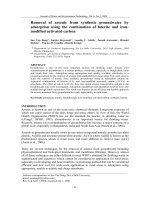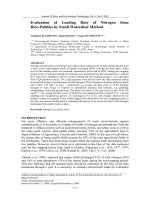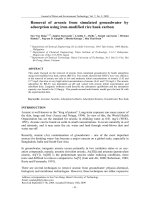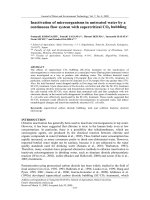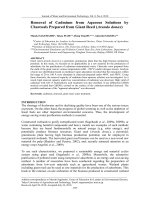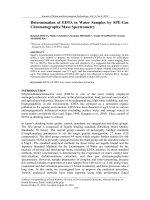Isotope fractionation of selenium during fugal biomethylation by
Bạn đang xem bản rút gọn của tài liệu. Xem và tải ngay bản đầy đủ của tài liệu tại đây (1.23 MB, 15 trang )
Isotope fractionation of Selenium during fungal biomethylation by Alternaria alternata
Nguyễn Thị Lâm
Number: 16
Student ID: 12000467
Outline
I
I. Introduction
There are a lot of researches about isotope of Se in plants, soils, water or sludge sewage..
By many different method:
* GC-MS
* Plasma- MS
* Natural microbial consortia
The aim of research:
1. Quantifying the degree of methylation of Se[VI] and Se[IV] by the
2. Determining the effects of there different Se
fungus A.Alternata at ph 4 and 7.
sources and pH values on 82Se/ 76Se in methylselenides
3. Determing the initial Se isotope fraction during methylation of
Se(IV) before the reaction ended,
Some definitions
- Methylation: In the chemical sciences, methylation denotes the addition of a methyl group to a substrate or the substitution of an atom
or groups by a methyl group
Se
methylselenides
Methylation by fungal
(Dimethylselenide,Dimethyldiselenide)
Incubation: the development and growth of bacteria, etc.
What is the selenium elements?
-
-
Selenium is a chemical element with symbol Se and atomic number 34
Se occurs naturally in four oxidation states (-II,0,IV,VI)
Se has 6 stable isotopes: 74Se( contribution to the total elemental mass: 0.94%), 76Se (9.37%), 77Se (7.64%), 78Se(23.77%),
80Se(49.61%) and 82Se (8.73%).
Biological functions:
essential trace element for animals and humans
most important role for selenium is as an anti-oxidant
Se is the ingredient in 2 amino acids (selenomethionie and selencysteine)
Selenoproteins play an essential role in the normal development and protection of brain cells
Reduce the toxicity of the toxic metals
Selenium still has a lot of others function such as prevention of cancer, electrical equipment and coloured glass ,etc.
Harmful
Consuming large amounts of selenium can cause toxicity, but this is unlikely to occur from food alone. The symptoms
of selenium toxicity include hair loss, vomiting, nausea,etc…
Sources of pollution include waste materials from certain mining, agricultural, petrochemical, and industrial
manufacturing operations
In Belews Lake North Carolina, 19 species of fish were eliminated from the lake due to 150-200 μg Se/L wastewater
from a Duke Energy coal-fired power plant. At the Kesterson National Wildlife Refuge in California, thousands of fish
and waterbirds were poisoned by selenium in agricultural irrigation drainage.
2. what about A.Alternata
Is a widely distributed filamentous fungus species
Is one of the most active terrestrial Se-methylation organisms
II. Materials and method
•
Materials
•
•
Stock standard solutions
Trap methylselenides
All samples were filtered through 0.45 um membrance filters
•
Incubation
•
•
•
The fungus was cultivated on agar plates at 30ºC for 5 days
•
Adjusting the pH of liquid culture to 4 and 7
The medium was contained in 250-mL EF with a rotatory shaker for 7 days to make an aerobic culture
Incubations were conducted in 80-mL serum bottles containing 20mL cultured medium spiked with Se(IV) and Se(VI)
to a final amount of 100 μg Se
Microaerobic condition and abiotic photochemical formation of methylselenides
•
•
Experiment
•
•
Preparing 4 treatments, each treatments contains Se(VI) or Se(VI) with pH 4 and 7
•
•
We collected trapped methylselenides on days 11-15
The fungal cultures were incubated for 11-15 days with Se(VI) and Se(IV), addition for 3-5 days with Se(IV) at
pH 7
On day 3-5 at pH of Se(IV) to determine separation factors ɛ of kinetic isotope fractionation of Se isotope
Trapping of methylselenides
•
•
•
Gas washing bottles contain alkaline peroxide solutions
Methylselenides were driven out by N2 stream
Growth media and fungi were digested by HNO3 to determine the Se remaining and accumulated in the fungi
Element and isotope analyses
Se isotope ratios were determined with MC-ICPMS
In conclusion
No methylation occurred without presence of the fungus
The formation of methylated compounds occurs for all Se species, however it is most rapid for Se(IV)
The fungus grew better under the neutral pH conditions
The average ε in the Se(VI) treatments were similar at pH 4 (ε = -3 ± 0.26º/oo) and pH 7 (ε = -2.72 ± 0.41º/oo)
The results(VI) demonstrate that
◦
The accummulation or assimilation step of Se(VI) leads possibly to a small fractionation while the methylated Se is likely
moderately fractionated.
In Se(IV) experiment
◦
◦
•
Methylselenides are significant enrich in 76Se compared to the supplied Se(IV)
•
Two parrallel main pathways were observed simultaneous, one leading to Se(0) and the other leading to methylselenides.
Methylselenides reflect a stronger fractionation for the methylation pathway than the reduction Se(0)
For the accumulation of Se in the fungus e is estimated as -4º/oo to -5º/oo from the difference between a rough estimate
In finally we conclude that the isotope composition of Se in methylselenides provides information about the sources of
methylselenides but it is not so much affected by pH
Future plan
In the future I want to research the method to improve polluted Se in environment by faster and more efficient
Thanks
For
Your
Attention!


